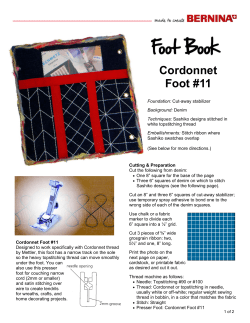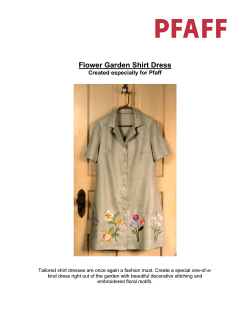
Cross-Hatched Placemats
Cross-Hatched Placemats Placemats are a quick and simple project for sewers of any skill level. Using modern fabrics and a geometric embroidery design, you can generate a new look to your dining room. Use the Palette (optional) or the Dual Feed Couching foot, along with the guide beam to create a gift that Mom will love. Don’t stop with the placemats; create a table runner to match! Skill Level: Intermediate Created by: Diane Kron, Software and Embroidery Project Manager Supplies: Baby Lock® Destiny sewing and embroidery machine Baby Lock Palette 10 Digitizing Software (optional) USB thumb drive (optional) Dual Feed Foot, Thread Guide with Couching Sole Baby Lock Tear-Away Stabilizer med wt. (optional) Baby Lock Soft Stabilizer for fusing 1 yard zigzag printed decorative fabric 1/2 yard solid yellow decorative fabric 1 yard of black cotton fabric Baby Lock Project: Crossed-Hatched Placemats Page 1 of 5 Madeira® black embroidery and Aerofil threads Crochet black thread for couching (size #8) Frixion Pen Batting Temporary spray adhesive General sewing and quilting supplies Instructions: Using the Dual Feed Foot 1. Cut out an 8” wide strip across the width of the yellow fabric. 2. Fuse the Baby Lock Soft Stabilizer to the back of the strip. 3. Using a straight edge ruler and the Frixion pen, draw several rows of lines on the strip at a 45° angle. For accuracy, use the markings on the ruler. 4. Set the machine up for sewing: a. Attach the Dual Feed foot with the couching sole. b. Attach the thread guide. c. Change the needle to a size 14 Quilting needle. d. Thread the machine with Madeira Aerofil Thread. e. Wind the bobbin with Finishing Touch bobbin thread. f. Under the Sewing category, select #1 tab. Select stitch number 1-09. If a stitch is greyed out, the stitch is not suitable for use with this foot. Under other stitch options, several stitches can be used. Set the width of the stitch at 2.0mm wide. g. Place the crochet thread on the top of the machine and thread the thread through the guides pulling it through the small hole on the foot. Leave approximately an 8” tail. Tip: It is easier to thread the yarn through the hole on the sole of the foot, with the foot detached from the foot. h. Activate the needle beam. Set the beam in the 3.5 position. Baby Lock Project: Crossed-Hatched Placemats Page 2 of 5 i. Place the 8” wide strip under the foot and begin to sew following the guide beam (as seen in the illustration below). Sew all the diagonal lines that go in the same direction and then reverse the section to stitch the reverse diagonal lines. j. For the third directional set of lines, place the stitched strip under the foot, with the guide beam centered over the crossed stitched line points. Guide the stitched section, using a moderate sewing pace. Tip: Do not look at the guide beam near the needle. Look out toward the end of the guide beam, centering the beam over the cross-points. You will never stitch a crooked line again using these two items. At the Computer: (Optional Steps 1-9) 1. Attach the dongle and open the Palette 10 program. Follow the next steps set up the workspace: Close the Wizards. From the Design Settings, select the 200mm x 300mm hoop. 2. On the top toolbar, select the Shapes icon and follow the next set of steps: Select the Zigzag Net fill Stitch as shown below. Baby Lock Project: Crossed-Hatched Placemats Page 3 of 5 3. 4. 5. 6. 7. 8. 9. Since we do not need an outline around the shape, click on the down arrow and select Not Sewn (Line). Select the color of thread you wish to use by clicking on the spool and selecting a color from the list. Take the cursor to the workpsace. Left click and drag to draw a rectangular shape that measures 130mm x 294mm. The size appears on the left side of the status bar, below the workspace. If you want to adjust the angle on the fill, click on the Sewing Attributes located to the left of the workspace. There are many options in this area, so feel free to make adjustments as desired. Note: on the bottom of window pane there is a viewing window to show the changes that you are making when you make them. In the sample, the triangle shape was selected and the direction was rotated to 270°. Density and Spacing may also be adjusted as desired. To save the design, click on File Save As and save to a thumb drive. Set the machine up for embroidery. Click on the Embroidery category and retrieve the design from the thumb drive. Set the design and click on Embroidery. Hoop the tear-away stabilizer and a section of the solid yellow fabric that will fit in the hoop. Place the hoop on the machine and embroider the design. Assembly: 1. Cut the stitched section to 6” x 13”. 2. From the print fabric, cut a section that measures 13” x 13”. 3. Piece the two sections together using a ½” seam allowance. Press the seam open. 4. From the zigzag fabric, cut a section for the backing so that it measures 1” larger around than the pieced section. Make a sandwich with the backing, batting and the pieced top section. 5. Set the machine up for sewing with the Dual Feed foot while using the standard sole and a straight stitch. Stitch-in-the-ditch on the seam line and then stitch over the zigzag lines on the fabric to quilt the placemats together. 6. Trim the edges so that the placemat measures 18” by 12”. 7. To bind the placemat, cut two 2½” wide strips from the black fabric. Piece the two strips together to make one long strip. With wrong sides together fold and press the strip. Fold one of the raw ends under ¼” at a 45° angle and press. Place the folded edge of the bias strip 6” down from the 18” edge and pin in place. Start to sew 4” down from the top edge of the bias strip and 3/8” from the raw edge of the placemat. Sew until you are 3/8” from the first corner. Cut the thread. Fold the bias strip up and away from the corner to create a 45° edge. Finger press. Fold the bias strip down over the second edge on the placemat and pin in place. (Be sure to maintain the 45° corner.) Continue to sew. Repeat when you get to the Baby Lock Project: Crossed-Hatched Placemats Page 4 of 5 second, third and fourth corner. When you get to the starting point of the bias strip, cut the ending strip so that it slides inside the starting bias strip point. 8. Fold the bias strip to the back and hand-sew in place. For other exciting projects like this one visit our website at www.babylock.com ©2015 Baby Lock USA. This project may be freely used by individuals for non-commercial purposes. Project instructions may not be sold or distributed without approval from Baby Lock. Baby Lock must be acknowledged as the source of the project instructions through copyright or online link Baby Lock Project: Crossed-Hatched Placemats Page 5 of 5
© Copyright 2025









